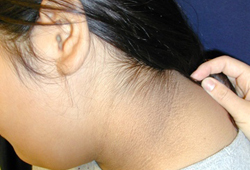Resumen
Definición
Anamnesis y examen
Principales factores de diagnóstico
- presencia de factores de riesgo
- acantosis pigmentaria
- poliuria
- polidipsia
- nicturia
Otros factores de diagnóstico
- hipertensión
- infección por hongos
- infecciones de la piel
- infecciones del tracto urinario
- fatiga
- visión borrosa
- pérdida de peso
Factores de riesgo
- obesidad
- predisposición genética/antecedentes familiares
- antecedentes étnicos de alto riesgo
- pubertad
- sexo femenino
- pequeño para la edad gestacional
- crecimiento rápido en la infancia
- entorno intrauterino diabético
- alimentación con biberón
- ingesta elevada de proteínas en la infancia
- ovarios poliquísticos
- contenido lipídico intramiocelular
- depósito de grasa en el hígado
Pruebas diagnósticas
Primeras pruebas diagnósticas para solicitar
- tira reactiva de orina
- glucosa plasmática al azar
- glucosa plasmática en ayunas
- HbA1c
- autoanticuerpos contra la insulina, las células de los islotes, los antígenos de los islotes, la decarboxilasa del ácido glutámico y el transportador de zinc 8
Pruebas diagnósticas que deben considerarse
- Glucosa plasmática a las 2 horas
- péptido C aleatorio
Algoritmo de tratamiento
Colaboradores
Autores
Jennifer Miller, MD

Professor
Department of Pediatrics
University of Florida
Gainesville
FL
Divulgaciones
JM declares that she has received research funding from Soleno Therapeutics, Harmony Biosciences, Tryp Therapeutics, and Rhythm Pharmaceuticals. JM is an author of a reference cited in this topic.
Chelsea Zimmerman, MD
Clinical Physician
Pediatric Endocrinology
Endocrinology and Metabolism of East Alabama
Opelika
AL
Divulgaciones
CZ declares that she has no competing interests.
Agradecimientos
Dr Jennifer Miller and Dr Chelsea Zimmerman would like to gratefully acknowledge Dr Arlan Rosenbloom and Dr Paul Hiers, previous contributors to this topic.
Divulgaciones
AR is an author of a number of references cited in this topic. Unfortunately, we have since been made aware that AR is deceased. PH declares that he has no competing interests.
Revisores por pares
Julian P. Hamilton-Shield, MB, ChB, MD(Bristol), MRCP, FRCPCH, FRCPCH
Professor
Diabetes and Metabolic Endocrinology
School of Clinical Sciences
University of Bristol
UK
Divulgaciones
In the past, JPHS received speaking honoraria from Sanofi-Aventis, Roche, Abbott, Novo-Nordisk, and Nutricia. None of these talks were directly pertinent to the treatment of type 2 diabetes.
Kristen Nadeau, MD
Professor of Pediatrics
University of California
Sacramento
CA
Divulgaciones
KN declares that she has no competing interests.
Dennis Styne, MD
Professor of Pediatrics
Rumsey Chair of Pediatric Endocrinology
University of California
Sacramento
CA
Divulgaciones
DS declares that he has no competing interests.
El uso de este contenido está sujeto a nuestra cláusula de exención de responsabilidad
